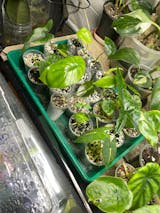Bio Leaf Stratum Active Aqua Soil - 2 sizes
- Regular Price
- $18.00
- Sale Price
- $18.00
- Regular Price
- Unit Price
- Translation missing: en.general.accessibility.unit_price_separator
Free soil scoop offer now sold out sorry, all free gifts have been claimed.
New from Bio Leaf comes Stratum, an active aqua soil for houseplants. This is a propagation substrate unlike anything else. Superb for mature alocasia and alocasia corms, for hard-to-root cuttings as well as recovery after root rot or root damage. This might be your new favourite substrate...
Why use Bio Leaf Stratum?
-
Faster propagation of corms and hard-to-root cuttings,
-
Made from volcanic earth, naturally high in organic humic and fulvic acids,
-
Increases root growth and helps protect from root rot and fertiliser burn,
-
Naturally unlocks nutrients, keeping them available to roots,
-
Increases nutrient transfer from substrate to roots,
-
Naturally buffers pH into the 'Goldilocks Zone' roots love (not too acidic, not too alkaline, just right!),
-
Readily uptakes nutrients and holds onto them, slowly releasing them over time,
-
Able to be recharged with fertiliser,
-
Plus no prep!
Is this the same as Fluval Stratum?
Fluval Stratum is the most well-known brand of aqua soil in the houseplant hobby. Very popular with planty content creators overseas. Fluval is the brand name, Stratum is what they call their aqua soil. Bio Leaf Stratum Active Aqua Soil is the closest match we can get here since Fluval Stratum isn't available in New Zealand. Bio Leaf's Stratum Active Aqua Soil is a similar size at 3mm to 5mm, also made from volcanic earth, and offers all the same overall benefits as Fluval Stratum (listed above), BUT it's better in three ways.
1: HARDER
Bio Leaf Stratum is harder, making it longer-lasting. All aqua soils break down slowly over time but Fluval Stratum is one of the softer and shorter-lasting aqua soils.
2: MORE NUTRIENTS
Bio Leaf Stratum is also higher in nutrients than Fluval Stratum, making it better for terrestrial plants (that includes our houseplants), whereas Fluval Stratum is lower in nutrients including ammonia in particular. Ammonia is a source of nitrogen for plants, but low-ammonia is better for fish in planted aquariums as ammonia is toxic to fish.
3: LONGER-LASTING
Bio Leaf Stratum also releases those nutrients over a longer period of time.
Do you still use fertiliser when using aqua soil?
Yes, you will still need to fertilise. Aqua soil is naturally rich in nutrients but not at high enough levels to replace the need for fertiliser, not long-term anyway. It's enough by itself to get roots started, but once your corm / cutting starts to root, use your usual rooting fertiliser, like GT CCS >
Is aqua soil like leca or pon?
Aqua soil is a similar size to pon (a little larger), and has the same round ball appearance as leca (but much smaller), but no, aqua soil is different to plant substrates like leca and pon.
Leca and pon are soil-free, sterile, don't break down and can be reused almost indefinitely. Aqua soil is made from soil, usually a nutrient-rich mix of volcanic soil, volcanic ash, clay and peat. It's organic, naturally high in humic and fulvic acids and able to buffer pH. Aqua soil will slowly break down over time and the nutrients can be recharged with fertiliser but it won't last forever.
Should you use aqua soil by itself or mixed with other substrates?
Both. You can use aqua soil by itself, or mix aqua soil with other substrates, most often combined about 50/50 with perlite. Mixing with perlite keeps costs down and increase the amount of air to further reduce the risk of root rot. A popular method is to start with a 50/50 mix of stratum and perlite, then top with a thin layer of straight perlite. Once rooted, you don't need to remove any attached aqua soil from the roots as it will naturally break down over time.
How do you prep aqua soil before use?
You don't need to and shouldn't rinse aqua soil before use. No prep required. You will find when you water that 'fines' will be washed out. That's the soil. Ideally you want to water gently using a mister or gentle flow of water to reduce soil loss. Rinsing before use just washes away soil and nutrients.
What containers do you use with aqua soil?
Two popular options: Either use in a container without drainage (those little clear plastic pots takeaway sauce comes in are great for corms in particular), or use mini pots like the Teku Mini and Rain 7.
I like to use two mini pots stacked together and I twist the bottom pot to 'close' the drainage holes to make them much smaller so I don't lose any aqua soil out the holes. If you use a container with no drainage make sure to water just to the point a little water starts to pool at the bottom. I'm also loving the self-watering 'pup cups' from The Rare Plantation >
How do you water when using aqua soil?
Aqua soil will change colour when dry (from black to a dusty charcoal). If you use a clear container, it's also easy to tell when the aqua soil dries out based on condensation. Water gently and lightly. Watering aqua soil too heavily can increase soil loss and speed up the breakdown of aqua soil (aqua soil becomes a little softer when wet and naturally breaks down slowly over time).
Aqua soil is quick to absorb water and holds on to it for a good amount of time depending on on airflow and humidity. If using a container without drainage, stop watering as soon as just a little water starts to pool in the bottom. Unlike leca or pon, you do not need a water reservoir as being soil-based, aqua soil holds a lot more water than leca or pon do.





